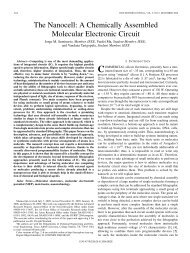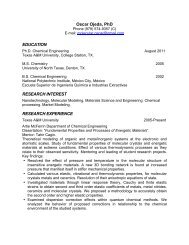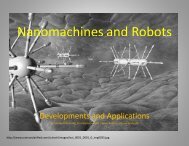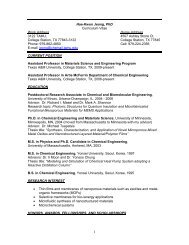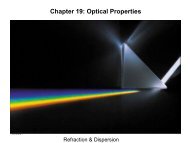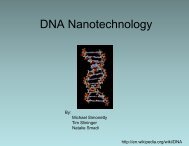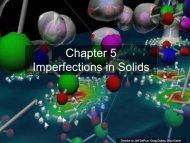Nanoparticles Nanoparticles as Catalysts in Chemical Reactions
Nanoparticles Nanoparticles as Catalysts in Chemical Reactions
Nanoparticles Nanoparticles as Catalysts in Chemical Reactions
- No tags were found...
Create successful ePaper yourself
Turn your PDF publications into a flip-book with our unique Google optimized e-Paper software.
<strong>Nanoparticles</strong> <strong>as</strong><strong>Catalysts</strong> <strong>in</strong> <strong>Chemical</strong><strong>Reactions</strong>Group 2
<strong>Nanoparticles</strong>• a particle with a diameter <strong>in</strong> the range of 1-100100 nanometers(10^-9 meters).• behave like a whole unit <strong>in</strong> terms of its properties.p• a large surface area to volume ratio.• allows the particles to be more reactive.ncem.lbl.gov/images/OAM/nanoparticle.jpg
<strong>Nanoparticles</strong>• significantly differentproperties then thematerial they makeup.• Special propertiespaffect the propertiesof the wholematerial.• Often referred to <strong>as</strong>clusters.http://www.nanoph<strong>as</strong>e.com/UserFiles/image/web%20%20nanoparticles%201.jpg
<strong>Nanoparticles</strong>• variety it of shapes such <strong>as</strong>spheres, cyl<strong>in</strong>ders, platelets,tubes, etc.• designed d with modifieddsurfaces designed to meetthe need of their specificapplication.• enormous diversity can beused to make this animportant t active field ofscience.<strong>Nanoparticles</strong> Synthesis, Stabillization, p<strong>as</strong>sivation andFunctionalization Ramanathan Nagarajan and T. Alan Hatton Aug2008
Synthesis of <strong>Nanoparticles</strong>• synthesized db by a variety of methods us<strong>in</strong>g g<strong>as</strong>, liquid, idorsolid ph<strong>as</strong>e processes.• Such <strong>as</strong> flame pyrolysis, y high temperature evaporation, andpl<strong>as</strong>ma synthesis.Mechanism of nanoparticle production us<strong>in</strong>g vapor ph<strong>as</strong>e of liquid ph<strong>as</strong>e/collodialMechanism of nanoparticle production us<strong>in</strong>g vapor ph<strong>as</strong>e of liquid ph<strong>as</strong>e/collodialmethods.<strong>Nanoparticles</strong> Synthesis, Stabillization, p<strong>as</strong>sivation andFunctionalization Ramanathan Nagarajan and T. Alan Hatton Aug2008
Assembl<strong>in</strong>g <strong>Nanoparticles</strong>Assembl<strong>in</strong>g nanoparticles for applications:(a) <strong>Nanoparticles</strong> with stabiliz<strong>in</strong>g polymer • <strong>as</strong>sembled <strong>in</strong> one, two or threemolecules around them <strong>in</strong> a random threedimensions, similar to howdimensional arrangement to create a porousnanoparticle system for catalytic oratoms and molecules areadsorption applications<strong>as</strong>sembled <strong>in</strong>to matter.(b) <strong>Nanoparticles</strong> <strong>as</strong>sembled on apolyelectrolyte or DNA molecule to serve <strong>as</strong>• specified locations on substratea nanoelectrical wire.to address and connect them to(c) <strong>Nanoparticles</strong> <strong>as</strong>sembled on a blockthe macroscopic outside worldcopolymer patterned surface withnanoparticles located at the doma<strong>in</strong>boundaries for a sensor application<strong>Nanoparticles</strong> Synthesis, Stabillization, p<strong>as</strong>sivation andFunctionalization Ramanathan Nagarajan and T. Alan Hatton Aug2008
Intro to Catalyst• Back <strong>in</strong> the early 1800's it w<strong>as</strong> observed that certa<strong>in</strong> chemicals can speed upa chemical reaction – a process that became known <strong>as</strong> catalysis and that h<strong>as</strong>become the foundation of the modern chemical <strong>in</strong>dustry.• By some estimates 90% of all commercially produced chemical products<strong>in</strong>volve catalysts t at some stage <strong>in</strong> the process of their manufacture.http://upload.wikimedia.org/wikipedia/commons/thumb/5/58/Rowlandson_-_<strong>Chemical</strong>_Lectures.jpg/400px-Rowlandson_-_<strong>Chemical</strong>_Lectures.jpg
What Catalyst do• Lower activationenergy of the reaction• Provides an alternatereaction pathway toget the products• Incre<strong>as</strong>es the rate of areaction because ittakes less energy to<strong>in</strong>itiate the forwardreactionhttp://www.biodieselchem.com/Portals/6/Energy%20Input.jpg
Catalysis•lower the rate-limit<strong>in</strong>g free energy change to a morefavorable transition rate•Examples: transition metals and certa<strong>in</strong> activated k<strong>in</strong>ds ofcarbon.http://depts.w<strong>as</strong>h<strong>in</strong>gton.edu/centc/Images/CatalysisCurve2009.jpg
Biochemical <strong>Catalysts</strong>•Most biochemical processes arecatalyzed with enzymes act<strong>in</strong>g <strong>as</strong> thecatalysts.•These enzymes are very important <strong>in</strong>natural processes of the body.http://universe-review.ca/I11-05-emzyme.jpg
Nanoparticle <strong>Catalysts</strong>• Nature reactive due to the largesurface are per volume.• This reactive nature makesnanoparticles a natural choicefor catalysts.• Us<strong>in</strong>g various preparationmethods nanoparticles can becustom designed <strong>in</strong> order toserve a specific purpose.• Biological nanoparticles havebeen used <strong>in</strong> nature s<strong>in</strong>ce thebeg<strong>in</strong>n<strong>in</strong>g of life.• Particle size h<strong>as</strong> large impact ofeffectiveness of catalyst.http://www.physorg.com/newman/gfx/news/newnanoparti.jpgh / / / / ti
Nanocatalyst Categories• four ma<strong>in</strong> categories b<strong>as</strong>ed on composition.• Plat<strong>in</strong>um or Palladium B<strong>as</strong>ed:Ex. Pt/Ru/Ni,• Gold B<strong>as</strong>ed:Ex. Au/TiO2, Au/MgO• Other Metal NanoparticleB<strong>as</strong>ed:Ex. Cu, Rh, V-Mg-O• Dispersed <strong>in</strong> Polymers:Ex. Pt/polypyrrole, l Cu/Polyanil<strong>in</strong>ehttp://www.julianhewitt.com/wordpress/wp-content/uploads/2008/03/plat<strong>in</strong>umore.jpg
Pt/Pd Nanoparticle <strong>Catalysts</strong>•The most common application of Pt/Pd nano-catalysts is the automotive catalyticconverter.•Also used <strong>in</strong> polymers, textiles, and solar energy materials•A major po<strong>in</strong>t of research <strong>in</strong> Pt/Pd nano-catalyst research is <strong>in</strong> the biomedical field•Plat<strong>in</strong>um b<strong>as</strong>ed metal nanoparticles are critical <strong>in</strong> fuel cell technology where cheapeffective catalysts are <strong>in</strong> great demand.http://image.truck<strong>in</strong>web.com/f/8330265/0708tr_22_z+2001_ford_f150_super_crew+broken_catalytic_converter.jpg
Gold Nanoparticle <strong>Catalysts</strong>• Gold <strong>as</strong> a material ischemically <strong>in</strong>ert(stable)and generally regarded<strong>as</strong> a poor catalyst.• M<strong>as</strong>ake Haruta resentlypublished a paper <strong>in</strong> <strong>as</strong>cientific journaldescrib<strong>in</strong>g how goldcan be an effectivecatalyst at nanoparticlesizes.• Haruta argues that thecatalytic properties ofgold depend on threema<strong>in</strong> factors:1. Contact Structure2. Support Selection3. Particle Sizehttp://www3.<strong>in</strong>terscience.wiley.com/cgi-b<strong>in</strong>/fulltext/104529618/ma<strong>in</strong>.html,ftx_absImage shows catalytic activity for theoxidation of H2 <strong>as</strong> a function of temperature.Traditional Gold requires a high h temperature tto even become a poor catalyst.
Gold Nanoparticle <strong>Catalysts</strong>http://www3.<strong>in</strong>terscience.wiley.com/cgib<strong>in</strong>/fulltext/104529618/ma<strong>in</strong>.html,ftx_abs• Haruta proved that gold can be a very potent catalyst when impregnated on other surfaces.• Impregnat<strong>in</strong>g various metals with gold nanoparticles resulted <strong>in</strong> an effective catalyst for the follow<strong>in</strong>g types ofreactions:1. Complete Oxidation2. Oxidative decompostion3. Redecution of NOx4. Oxidation or reduction of COx5. Selective oxidation6. Selective Hydrogenation7. HydroChlor<strong>in</strong>ation• Percent of conversion is highly dependany on Catalytic Metal Load<strong>in</strong>g Percent and Mean Particle Diameter.
Gold Nanoparticle <strong>Catalysts</strong>• Effective particle size for goldNanocatalyst is less than 5 nm.• Decre<strong>as</strong>e of the surface arecoord<strong>in</strong>ation number and themobility of surface gold atomslead to greater reactivity.• Contact structure is importantbecause it governs theavailability and order of thegold atoms.• Gold nanoparticle catalystsrema<strong>in</strong> effective at lowtemperatures.http://www.livbit.com/article/wp-content/uploads/2008/12/gold-nanoparticles.jpg
Other Metal Nanoparticle<strong>Catalysts</strong>• A sample nanoparticle catalyst for the oxidation of methanol is Pt/Ru/Ni nanoparticle alloys.• Nanoclusters of silver atoms have been proven to be effective catalyst for ethyleneepoxidation.• Cluster of atoms are restricted by their method of creation, for example e-beam constructionof nanoclusters results <strong>in</strong> a m<strong>in</strong>imum particle size of 20nm.• It h<strong>as</strong> also been reported that the addition of b<strong>as</strong>e metals such <strong>as</strong> iron, cobalt and nickel toplat<strong>in</strong>um also improves the oxygen-reduction reaction rate, but these k<strong>in</strong>ds of b<strong>as</strong>e metalsdissolve e<strong>as</strong>ily <strong>in</strong> the acidic environment of a PEFC where the catalyst is work<strong>in</strong>g, which is aproblem.http://www.<strong>in</strong>diana.edu/~bdlab/images/cryovlp.jpg
Nanoparticle Preparation• Prepar<strong>in</strong>g a nanoparticle catalyst <strong>in</strong>volves somehowmount<strong>in</strong>g the particles onto a support structure.• The ma<strong>in</strong> hurdle <strong>in</strong> <strong>Nanoparticles</strong> creation is the lack ofcontrol over shape, size and stability.• Ideally the Nanocatalyst should ldb be stable and have veryprecise dimensions.• The various preparation p routes for creat<strong>in</strong>g nanoparticlecatalysts are:• Physical• <strong>Chemical</strong>• Physicochemicalhttp://www.ims.demokritos.gr/img_research/Dimosthenis1.JPGhttp://chemistry.dal.ca/Images/Zhang/fig1.jpg
Nanoparticle Preparation<strong>Chemical</strong> Methods• <strong>Chemical</strong> methods of attach<strong>in</strong>g nnprtil nanoparticles to support materials are:• Co-precipitation• Deposition-precipitationprecipitation• Ion-exchange• Impregnation• Successive Reduction• Calc<strong>in</strong>ations• Surface Capp<strong>in</strong>g• Microemulsions• Photochemistry• <strong>Chemical</strong> Vapor Deposition• Electrochemical Reduction• Etc• <strong>Chemical</strong> techniques are the oldest andhave been proven to be successful.<strong>Nanoparticles</strong> Synthesis, Stabillization, p<strong>as</strong>sivation and FunctionalizationRamanathan Nagarajan and T. Alan Hatton Aug 2008
Nanoparticle Preparation• Impregnation- a metal nanoparticle precursordissolved <strong>in</strong> a solvent.- added to a porous support so that athick slurry is formed.- The solvent is then removed and thesolid is recovered and tested.• Co-precipitation- the metal and its support precipitatefrom solution at the same time.- Us<strong>in</strong>g this method metal nanoparticlescan become imbedded di<strong>in</strong>to porousmaterials.• Precipitation-Deposition- the dissociation of the metal precursorfollowed by a change <strong>in</strong> pH toprecipitate the nanoparticles onto thesurface of a support.<strong>Chemical</strong> Methodshttp://www3.<strong>in</strong>terscience.wiley.com/cgi-b<strong>in</strong>/fulltext/121637625/ma<strong>in</strong>.html,ftx_abs
Nanoparticle Preparation<strong>Chemical</strong> Methods• Microemulsions- Microemulsions are similar toimpregnation however the metal salt isdissolved <strong>in</strong> a emulsion which thenimpregnates the porous supportstructure. This method h<strong>as</strong> resulted <strong>in</strong>greater control of particle size.• Photochemistryh t- Photochemistry <strong>in</strong>volves a high wattagelight source <strong>in</strong> order to excite moleculesand add energy to reactions. Theadditional energy allows for depositionsthat might not normally occur.http://www.fbi.gov/hq/lab/labannual05/page_iiic.jpg• <strong>Chemical</strong> Vapour Deposition- This method <strong>in</strong>volves the vaporizationof metals followed by the formation andgrowth of nanoparticles under vacuumconditions. This method allows for awide variety of support structures.
Nanoparticle PreparationSurface Capp<strong>in</strong>g• Surface capp<strong>in</strong>g is an emerg<strong>in</strong>gsolution to some of thelimitation of conventionalchemical nanoparticlepreparation.• Surface capp<strong>in</strong>g employeespolymeric or molecular capp<strong>in</strong>gagents to <strong>in</strong>cre<strong>as</strong>e control overnanoparticle size and surfaceproperties.• <strong>Nanoparticles</strong> formed are often<strong>in</strong> a shell structure with themetal tl at tththe core and dththepolymers <strong>as</strong> the outside layer.• By controll<strong>in</strong>g the amount ofcapp<strong>in</strong>g agent nanoparticleshape, size and stability can becontrolled.http://www.molecular<strong>as</strong>sembler.com/Papers/PDMM/Slide68.GIF
Nanoparticle PreparationPhysical Methods• Physical and Physicochemicalh techniques generally <strong>in</strong>volvemore expensive technology butpromise more control overnanoparticle creation.• The ma<strong>in</strong> physical methods forcreat<strong>in</strong>g nanoparticle catalystsare:- Sonochemistry- Microwave Irradiationi- Pulsed L<strong>as</strong>er Ablation- Supercritical Fluids- Pl<strong>as</strong>ma- Etc.http://ag.arizona.edu/swes/r<strong>as</strong>mussen/pics/XRD_pics/DSC02074.JPG
Nanoparticle PreparationPhysical Methods• Sonochemistry uses sonic waves toalter molecule properties. affect thesurface structure of the metalsusually enhanc<strong>in</strong>g the surfacecontact area.• Microwave Irradiation <strong>in</strong>volvesexpos<strong>in</strong>g metal salt solutions tomicrowave irridiation <strong>in</strong> order toprepare a wide range ofnanocatalysts.• Supercritical fluids can be employedto create supported nanoparticlecatalysts by provid<strong>in</strong>g a solutionwith a lower viscosity it and lesssurface tension.http://www.bloodhoundssc.com/_db/_images/sonic_boom.jpg
New AdvancementsFuel CellsCarbon Nanotubeshttp://www.chem.um<strong>as</strong>s.edu/m<strong>as</strong>screst/fuel<strong>in</strong>gthefuture/images/fuelcell.jpghttp://neurophilosophy.files.wordpress.com/2006/08/multiwall-large.jpg
Fuel Cells• A new type of catalystcreated tdbby surround<strong>in</strong>g ananoparticle of ruthenium(Ru) with one to twolayers of plat<strong>in</strong>um (Pt)atoms.• Improves a key hydrogenpurification reaction andleaves more hydrogenavailable to make energy <strong>in</strong>the fuel cell.www.cafcp..org
Fuel Cells• began with relatively largeplat<strong>in</strong>um particles scattered ona carbon surface.• oscillat<strong>in</strong>g voltage, which<strong>in</strong>duces alternat<strong>in</strong>g chemicalreactions that determ<strong>in</strong>ewhere plat<strong>in</strong>um atoms willaccumulate and where theywon't.• layer of plat<strong>in</strong>um oxide formson other parts of thenanoparticle, protect<strong>in</strong>g ti them.• The result<strong>in</strong>g 24-sided shapes,called tetrahexahedra, were thefirst such shapes formedartificially <strong>in</strong> metals, saysZhong L<strong>in</strong> Wang, professorof materials science andeng<strong>in</strong>eer<strong>in</strong>g i at Georgia Tech.http://www.technologyreview.com/files/10884/catalyst_x220.jpg
CNT’s (Carbon Nano Tubes) <strong>as</strong>• Researchers at the FritzHaber Institute of theMax Planck Society <strong>in</strong>Berl<strong>in</strong> have been work<strong>in</strong>gfor some time at metal-free catalysis us<strong>in</strong>gnanocarbons.• While their focus <strong>in</strong>itiallyh<strong>as</strong> been on ethylbenzene,an aromatic hydrocarbonthat plays an importantrole <strong>as</strong> an <strong>in</strong>termediate <strong>in</strong>the production of variouspl<strong>as</strong>tic materials, they nowhave, for the first time,used carbon nanotubes(CNTs) to activate butane.Catalysthttp://scitizen.com/cacheDirectory/HTMLcontributions/img/Artist%20vision%20of%20nanotube.gif
CNT cont’d• CNTs can make certa<strong>in</strong> important chemical reactions more effective, more energy efficient, and safer.• "Carbon nanotubes were used <strong>as</strong> catalysts before, for <strong>in</strong>stance <strong>in</strong> convert<strong>in</strong>g ethylbenzene <strong>in</strong>to styrene, aprecursor to polystyrene, an important synthetic material" Dr. Dangsheng Su expla<strong>in</strong>s to Nanowerk.• "But butane is much less reactive than ethylbenzene and we were surprised how well it worked – the highselectivities we observed were unexpected."http://endomoribu.sh<strong>in</strong>shu-u.ac.jp/research/cnt/images/cat_cnt.jpg
Other Catalyst Uses• One popular <strong>in</strong>dustry that uses nano-catalysts is the energyprocess<strong>in</strong>g field.• Petroleum ref<strong>in</strong>eries and automobiles use this technology.• Biodiesel and biofuels use both <strong>in</strong>organic and biocatalysts.http://www.lansdownephotography.co.uk/<strong>as</strong>sets/photos/<strong>in</strong>dustrial/<strong>Chemical</strong>%20Plant.jpg
Other Catalyst Uses• BlkBulk and dfif<strong>in</strong>echemicals areproduced throughcatalytic reaction.• F<strong>in</strong>e chemicals usemore nano-catalysts than bulk.• This is becausef<strong>in</strong>e chemicals areusually for researchand require moreexpensive nano-particles.http://www.ndsu.edu/research/images/Generic_scientist_blue.JPG
Other Catalyst Uses• The most researchedarea of nano-catalystsisthatofthat biocatalysis.• Food process<strong>in</strong>gth<strong>in</strong>gs like margar<strong>in</strong>euse nano-catalysts.• Scientists areresearch<strong>in</strong>g the roleof nano-catalysts <strong>in</strong>the medical field.http://www.ccgov.net/departments/HR/images/medical%20symbol.gif
Why have nanocatalysts?• Catalyz<strong>in</strong>g reactions canaffect a variety ofapplications <strong>in</strong> doma<strong>in</strong>ssuch <strong>as</strong> ref<strong>in</strong><strong>in</strong>g of oil, fuelcells, renewable energy,ground water remediation,catalytic converters,chemical and polymermanufactur<strong>in</strong>g,pharmaceutical andbiomedical applications,food process<strong>in</strong>g, paperand pulp recycl<strong>in</strong>g, andtextile production.Nanocatalyst technologycould well be the solution tothe many ensu<strong>in</strong>g challengesthat range from processefficiencies to breadth ofproduct applications.http://www.eimcowatertechnologies.com/fandb/images/stories/recycl<strong>in</strong>gimages/recycle%20symbol%20copy.png
Why have nanocatalysts?• Despite several factors propell<strong>in</strong>g p the development of nn nanocatalysts tl t and theiradoption <strong>in</strong> numerous applications, technological challenges that the sector is yet toaddress <strong>in</strong>clude ma<strong>in</strong>ta<strong>in</strong><strong>in</strong>g nanocatalyst stability and activity, agglomeration ofnanoparticles, control of the size nanoclusters, and reusability of nanocatalysts.http://www.physorg.com/newman/gfx/news/newnanoparti.jpghttp://www.atm.ch.cam.ac.uk/~paul/
Works Cited• http://carefreeenzymes.com/sitebuildercontent/sitebuilderpictures/EnzymeExample.jpg• http://image.truck<strong>in</strong>web.com/f/8330265/0708tr_22_z+2001_ford_f150_super_crew+broken_catalytic_converter.jpg• http://www.americanelements.com/ptnp.html• http://www.ndsu.edu/research/images/Generic_scientist_blue.JPG• http://www.<strong>in</strong>placemach<strong>in</strong><strong>in</strong>gjvic.com/images/<strong>in</strong>dustries_ref<strong>in</strong>ery.jpg• http://www3.<strong>in</strong>terscience.wiley.com/cgi-b<strong>in</strong>/fulltext/88013153/PDFSTART/ / / /• http://www.spr<strong>in</strong>gerl<strong>in</strong>k.com/content/n7v6851033871433/fulltext.pdf• http://en.wikipedia.org/wiki/Nanoparticle• http://en.wikipedia.org/wiki/Catalysis• http://books.google.com/books?id=21OcPcgGNr4C&pg=PA120&lpg=PA120&dq=types+of+nanoparticle+catalysts&source=bl&ots=gF7IIbdzQq&sig=03D9rjkHNGaq3WeQ4UOW_CN4SF0&hl=en&ei=_ZLTSujgN4WiswPErdXvCw&sa=X&oi=book_result&ct=result&resnum=1&ved=0CBAQ6AEwAA#v=onepage&q=types%20of%20nanoparticle%20catalysts&f=false• http://www3.<strong>in</strong>terscience.wiley.com/cgi-b<strong>in</strong>/fulltext/104529618/HTMLSTART• http://www3.<strong>in</strong>terscience.wiley.com/cgi-b<strong>in</strong>/fulltext/121637625/HTMLSTART
Works Cited• http://www.purchon.com/chemistry/catalyst.htmpurchon com/chemistry/catalyst htm• http://www.chem4kids.com/files/react_catalyst.html• http://www.<strong>as</strong>tro.virg<strong>in</strong>ia.edu/cl<strong>as</strong>s/oconnell/<strong>as</strong>tr121/cosmic-history-narrative.html• http://www.eso.org/public/events/<strong>as</strong>tro-evt/DeepImpact/Impact/obseso4.htmlevt/DeepImpact/Impact/obseso4.html• http://www.eng<strong>in</strong>.umich.edu/dept/che/research/l<strong>in</strong>ic/projects-au-support.html• MRS – Symposium Proceed<strong>in</strong>gs Vol. 900 – <strong>Nanoparticles</strong> and Nanostructures <strong>in</strong> Sensors and Catalysis – Fall 2005• http://neurophilosophy.files.wordpress.com/2006/08/multiwall-large.jpglarge.jpg• http://www.nanowerk.com/spotlight/spotid=7576.php• http://www.technologyreview.com/nanotech/18669/?a=f• http://www.news.wisc.edu/1492• http://www.sciencedaily.com/rele<strong>as</strong>es/2009/03/090319102321.htm• http://lpc1.clpccd.cc.ca.us/lpc/rschmidt/<strong>in</strong>dex.html• <strong>Nanoparticles</strong> Synthesis, Stabillization, p<strong>as</strong>sivation and Functionalization Ramanathan Nagarajan and T. Alan Hatton
NanoParticle <strong>Catalysts</strong>NanoParticle<strong>Catalysts</strong>Group 2Archie Buchman, Kelly BufordJonathan Campoverde, Michael Dean,Snthesis Synthesis Purpose New Advances Categories Oerie Overview<strong>Chemical</strong>Incre<strong>as</strong>e ProcessEfficiencyCarbonNanotubesPt/RdWhat is aCatalystPhysicalLower ProcessCostFuel CellsGoldWhat is aNanoparticlePhysicochemicalEnable newProcessesOther MetalPolymerhttp://www.nd.edu/~gezelter/Ma<strong>in</strong>/float<strong>in</strong>g-nanoparticle.jpg



